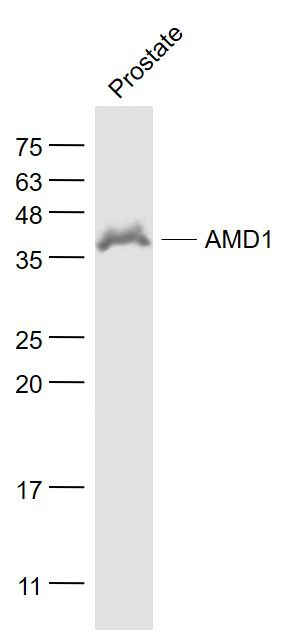产品货号 : mlR21351
英文名称 : AMD1/SAMDC
中文名称 : S-腺苷蛋氨酸脱羧酶抗体
别 名 : AMD1; S-adenosylmethionine decarboxylase; Adenosylmethionine decarboxylase 1; AdoMetDC; EC 4.1.1.50; FLJ26964; S adenosylmethionine decarboxylase 1; S adenosylmethionine decarboxylase proenzyme; SamDC.
研究领域 : 肿瘤 细胞生物 信号转导
抗体来源 : Rabbit
克隆类型 : Polyclonal
交叉反应 : Human, Mouse, Rat, Dog, Pig, Cow, Horse,
产品应用 : WB=1:500-2000 ELISA=1:500-1000 IHC-P=1:400-800 IHC-F=1:400-800 ICC=1:100-500 IF=1:100-500 (石蜡切片需做抗原修复)
not yet tested in other applications.
optimal dilutions/concentrations should be determined by the end user.
分 子 量 : 38kDa
细胞定位 : 细胞浆
性 状 : Lyophilized or Liquid
浓 度 : 1mg/ml
免 疫 原 : KLH conjugated synthetic peptide derived from human AMD1/SAMDC:68-170/334
亚 型 : IgG
纯化方法 : affinity purified by Protein A
储 存 液 : 0.01M TBS(pH7.4) with 1% BSA, 0.03% Proclin300 and 50% Glycerol.
保存条件 : Store at -20 °C for one year. Avoid repeated freeze/thaw cycles. The lyophilized antibody is stable at room temperature for at least one month and for greater than a year when kept at -20°C. When reconstituted in sterile pH 7.4 0.01M PBS or diluent of antibody the antibody is stable for at least two weeks at 2-4 °C.
PubMed : PubMed
产品介绍 : The product of this gene is an important intermediate enzyme in polyamine biosynthesis. The polyamines spermine, spermidine, and putrescine are low molecular weight aliphatic amines essential for cellular proliferation and tumor promotion. This protein spans 22 kb comprised of 9 exons and 8 introns and encoding two species of mRNA of 2.1 and 3.4-3.6 kb originating from the use of two different polyadenylation signals. The pro protein is an approximate 38.3 kDa which is known to undergo processing at amino acid 68 to yield two fragments of 32 and 6kDa.
Post-translational modifications:
Is synthesized initially as an inactive proenzyme. Formation of the active enzyme involves a self-maturation process in which the active site pyruvoyl group is generated from an internal serine residue via an autocatalytic post-translational modification. Two non-identical subunits are generated from the proenzyme in this reaction, and the pyruvate is formed at the N-terminus of the alpha chain, which is derived from the carboxyl end of the proenzyme. The post-translation cleavage follows an unusual pathway, termed non-hydrolytic serinolysis, in which the side chain hydroxyl group of the serine supplies its oxygen atom to form the C-terminus of the beta chain, while the remainder of the serine residue undergoes an oxidative deamination to produce ammonia and the pyruvoyl group blocking the N-terminus of the alpha chain.
Similarity:
Belongs to the eukaryotic AdoMetDC family.
SWISS:
P17707
Gene ID:
262
Important Note:
This product as supplied is intended for research use only, not for use in human, therapeutic or diagnostic applications.
产品图片












